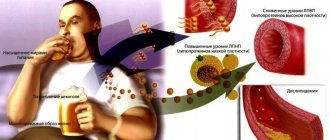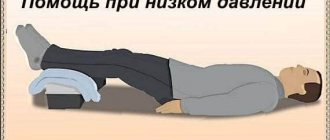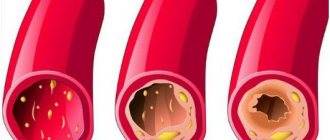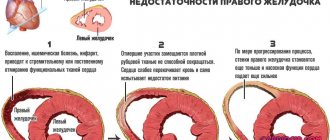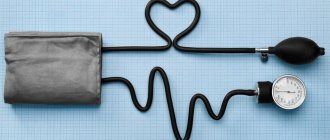Hypertension is a serious disease, especially often diagnosed in men and women who have crossed the 40-year mark. Its danger lies in the fact that if not treated in a timely manner, the disease can cause strokes and heart attacks. Therefore, many are wondering: what to do when a pressure of 200 to 100 is detected and what first aid should be given to a person.
Treatment of pathology
The patient should eat foods rich in vitamins, seasoned with very little salt.
If a patient’s blood pressure is 200 to 120, then treatment for the disease should be comprehensive and depend on the stage, severity, presence of concomitant diseases and other important factors. First aid consists of taking medications that will help quickly reduce high blood pressure and improve the patient’s overall well-being. For this purpose, diuretics and non-selective adrenergic blockers are used, as they have a lightning-fast and very pronounced effect. Non-drug treatment consists of normalizing lifestyle and getting rid of bad habits. It is necessary to eat foods rich in vitamins and with a minimum amount of salt. A useful active motor mode, but without overwork and excessive physical activity.
Return to contents
First aid: what to do?
To lower the pressure from 200 to 110, it is necessary to provide the patient with a flow of fresh air before the ambulance arrives and place him on a pillow with a high headboard. Hot foot baths, showers, or mustard plasters will help to slightly reduce blood pressure, which helps dilate blood vessels. You can also take an antihypertensive drug, which the patient uses to normalize blood pressure. Nitroglycerin is an emergency treatment for high blood pressure. The tablet should be taken under the tongue, and more than 3 tablets should be used. life threatening. Magnesia injections are used to relieve the main symptoms of high blood pressure.
A decrease in blood pressure to normal values means that you need to stop taking antihypertensive drugs.
Return to contents
Medicines
The medication will reduce the load on the heart muscle and normalize heart rate.
To normalize the patient's condition, if the pressure is 200 to 130 or higher, various groups of antihypertensive drugs are used. The most common among them are beta-blockers, which reduce the strength and frequency of heart contractions, and also reduce the load on the myocardium. Metoprolol, Bisoprolol and Atenolol are used. ACE inhibitors, calcium channel blockers and calcium antagonists are also used. These medications must be taken constantly, even with normal blood pressure, as they eliminate the causes of hypertension
It is important to combine antihypertensive drugs with diuretics. Antiarrhythmic drugs are also needed
The use of fibrinolytics, vitamin-mineral complexes and angioprotectors, which reduce the number of complications, is indicated.
Folk recipes
Using traditional medicine will help reduce blood pressure by 200 to 90. Most often, herbal medicine is used for this purpose. It is recommended to make decoctions from the herbs of hawthorn, chamomile, calendula and motherwort. You can drink 1 teaspoon of aloe juice every morning on an empty stomach. A garlic infusion with alcohol is used, which is used once every day for a month. Blackcurrant, watermelon and honey will be useful. With a significant increase, it is recommended to make rubdowns and compresses from vinegar diluted in half with water.
Emergency care for severely elevated blood pressure
If the pressure rises strongly and often, then in no case should you self-medicate. Only qualified medical care can help you improve your health.
Doctors usually advise stabilizing the condition with:
- Clonidine;
- Dibazole;
- Arfonada;
- Pentamina;
- Magnesium sulfate;
- Uregita;
- Furasemide;
- Phentolamine.
But these medications can only be used in emergency cases, since their frequent use is undesirable. Each of these medications is selected individually for each person. This is why consultation with a doctor before taking them is mandatory.
If there is absolutely no way to get medical help, you can try to normalize the condition yourself. But you just need to strictly follow the instructions below.
- The first thing, of course, you need to use a tonometer to know how much higher the readings are than normal.
- If the numbers are not threatening and the deterioration of the condition is not associated with chronic diseases, you can use proven traditional medicine recipes. In this case, an infusion brewed from herbs can provide effective assistance.
- If the increase in pressure occurred due to a certain stressful situation, you need to try to relax and calm down. Perhaps it will be enough to be alone and just lie down.
- If the tonometer shows numbers greater than 200/100, then in most cases the condition can be stabilized only with the use of medications. Most often in such situations they use Clonidine, magnesium sulfate, Verapamil, Nifedipine. But you are allowed to take only one tablet, since an increased dosage will also not lead to anything good, but will only contribute to the deterioration of the condition.
- The effect of the medicine taken usually begins within 30 minutes - 1 hour. After this time, blood pressure decreases. Therefore, it is important not to take any further medications during this period. This is fraught with a rapid and sharp decrease in pressure, which poses a danger to life. If, thanks to one of the remedies, you managed to improve your well-being, then you need to at least temporarily give up cigarettes and alcohol, and try to avoid stressful situations.
- If blood pressure has not returned to normal, and the condition has only worsened, then it is recommended to use some kind of diuretic. One of the most popular and effective is Furosemide. Ethacrynic acid is no less effective. Their effect begins to be felt after an hour.
- If all of the above methods do not have any effect, then you need to find an opportunity to seek medical help.
These recommendations are relatively general and are usually applied in standard situations required to reduce blood pressure. If only one of the numbers increases, then only specific drugs can help.
- Lower indicators are usually reduced with the help of Atenolol, Verapamin, Enalapril and other means that are analogues of the above.
- Reducing the upper numbers is achieved by using Metoprolol, Captopril and Inifidepine.
- If the tonometer needle shows more than 200/100, then in this case it is better to use Andipal, Enapril and Kartopress .
All of the medications listed should be taken strictly according to the instructions and take into account the doctor’s recommendations.
Blood pressure 200 over 90 what to do treatment
It is necessary to begin therapy with the use of one antihypertensive drug.
The following regimens are used, one of the indicated drugs:
ACE inhibitor (enalaprilat) 1.25 mg (1 ml) IV in a slow stream over 5 minutes, previously diluted in 20 ml of a solution of 0.9% sodium chloride solution, repeat the dose if necessary (maximum dose - 2.5 mg) ; beta blocker (propranolol) 5 mg (0.1% - 5 ml) is administered in the same way, the maximum allowable dosage is 10 mg; calcium channel blocker (verapamil) 5 mg (0.25% - 5 ml) is administered when propranolol is contraindicated.
Symptoms with a pressure of 200 over 100
If high blood pressure persists for long periods of time and very rarely returns to normal on its own, then due to its changes, the speed of blood flow increases and the walls of blood vessels become thicker, and because of this, the lumen in them decreases. During this period, the sick person has the following symptoms:
- pain in the back of the head, a feeling of pulsation, especially in the temporal part;
- blurred vision, pathological changes in the fundus, dilated blood vessels;
- constant fatigue, even in the morning;
- noise in ears;
- rapid heart rate, aching pain in the heart area;
- swelling of the eyelids, face, hands;
- redness of the facial skin, appearance of vascular networks;
- memory impairment;
- numbness of the limbs, sweating;
- involuntary urination, urine analysis reveals albumin proteins;
- sudden changes in pressure - hypertensive crisis.
High blood pressure danger
Advanced hypertension negatively affects all human organs, namely:
- Brain. With hypertension, the lumen in the blood vessels narrows, which leads to oxygen starvation of this most important organ, and as a result, a stroke may ultimately occur.
- The cardiovascular system. High blood pressure provokes severe stress on the vessels, they wear out more quickly and fatty plaques are deposited on their walls. With changes in the healthy functioning of blood vessels, the nutrition of the heart muscle stops, and this entails angina pectoris. If left untreated or improperly treated, high blood pressure will lead to a heart attack.
- Urinary system. With changes in its operation, the filtering function deteriorates. A large amount of protein and other substances entering the circulatory system are detected in the urine. If treatment is ignored in older people, this leads to kidney disease.
- Organs of vision. High pressure negatively affects the microvessels located in the human eyeball. Due to frequent changes in pressure, irreversible changes in the retina occur.
What causes high blood pressure?
Often, high blood pressure is a response to another serious abnormality in the body. In this case, before reducing arterial hypertension, it is recommended to find out the possible cause. People at risk are:
- Experiencing constant emotional turmoil. Worries don't always have to be associated with negativity. Simply excessive expression of strong emotions greatly affects the functioning of the heart, as a result of which a sharp rise in pressure can occur.
- With a violation of the integrity and tone of blood vessels. Vessels are the main factor responsible for arterial parameters. Many functions of the body depend on whether they keep up with the work of the heart (contract or relax in time).
- With kidney pathologies. The kidneys are almost entirely responsible for lower (diastolic) pressure. If there are any difficulties with a real organ, jumps are possible.
- Elderly. Over time, the body's functional reserves are depleted, and more strength is required for normal activities. Blood pressure indicators increase by several units every five years.
- Overweight. Overweight people almost always suffer from hypertension and tolerate the disease much more difficult.
- Suffering from a hangover in the morning. The breakdown of alcohol causes spasms of blood vessels in the brain, which also causes a surge in pressure. To cope with an attack, it is enough to relax the blood vessels by drinking an antispasmodic.
Pressure 200120 and its causes
Pressure 200/120(110), which arose spontaneously, is a clear sign of a hypertensive crisis. With a regular and gentle increase to such indicators, the patient is diagnosed with arterial hypertension. This disease can occur for various reasons. Most often it is caused by:
- improper functioning of the kidneys;
- congenital disorder of the aorta structure;
- the presence of malignant tumors in the body;
- changes in the functioning of the thyroid gland;
- toxicosis in the later stages of pregnancy;
- regular consumption of strong alcoholic drinks;
- use of certain groups of drugs.
After 40 years of age, the risk of developing hypertension increases
Most often, arterial hypertension with levels of 200/120 occurs in people over 55 years of age. Over time, the walls of blood vessels become thinner. They are no longer as elastic as before
It is important to emphasize that lowering blood pressure in an older patient is not easy.
Most often, blood pressure of 200/120 occurs in representatives of the stronger sex. They are more susceptible to arterial hypertension.
There are other causes of the disease, reflected in the table.
| Factor provoking the development of hypertension | Ways to normalize the condition |
| Bad habits | You need to completely give up alcohol-containing drinks, drugs and smoking. Such habits have a detrimental effect not only on the cardiovascular system, but also on the entire body. |
| Poor nutrition | It is necessary to exclude from the diet canned food, drinks with a large number of chemical additives, sausages and many deli meats, confectionery, flour, sauces not prepared at home, fast food and various salty snacks. The amount of salt in the daily diet should be reduced to 4 grams. |
Arterial hypertension and readings of 200/120(110) can also occur due to:
- presence of a large number of extra pounds;
- sedentary lifestyle;
- lack of proper rest;
- sensitivity to stressful situations;
- emotional shock.
What blood pressure should be normal for older people?
Arteries are large vessels that are located next to the skin, which is why it is quite simple for an elderly person to determine and, especially, increase blood pressure at home.
The movement of blood also occurs in the small capillaries and veins present in the body, due to which blood pressure is often called “blood pressure”. In small vessels it is measured under special conditions and with special instruments, which is very difficult to do without the combination of these components.
The heart tends to contract with a certain force and speed, and it is at the moment of contraction that blood is released into the arterial system. It has different properties for each person and the walls of blood vessels can react differently to this release. Blood pressure in older people reacts sharply to this ongoing process.
So, blood pressure is the process when blood exerts pressure on the walls of blood vessels with a certain force.
- Recommended articles to read:
- Social services for older people
- Diseases of old age
- Valuable tips on how to choose a boarding house
This process is influenced by several factors:
- Atherosclerotic changes - the elasticity of the walls of blood vessels decreases;
- Elasticity of vascular walls - blood vessels wear out and can no longer withstand the load, which causes high blood pressure in older people or hypertension;
- The endocrine glands become diseased;
- Sudden stretching or contraction of blood vessels during a moment of emotional stress, when strong emotions, such as fear or rage, flare up involuntarily. During hormonal changes, vascular deformations also occur;
- The properties of the heart to contract and distribute the correct movement of blood throughout all vessels in each individual organism;
- Rheological properties of blood. When the blood becomes thick, it can clot and its movement through the vessels becomes difficult, which can lead to diabetes and spikes in blood pressure. Doctors sometimes recommend using leeches to thin the blood.
Symptoms with a pressure of 200 to 130
This disease is dangerous because pressure changes increase the speed of blood flow, therefore, the walls of the vessels become thicker and because of this, the lumen in them decreases and a strong blood flow easily breaks such vessels, so hemorrhages can occur.
If the pressure rises to 200 to 130, then the doctor diagnoses the third degree of hypertension, and it is characterized by the following symptoms:
- nausea;
- vomit;
- trembling throughout the body;
- headache, dizziness;
- feeling of pulsation in the head, cloudiness of consciousness;
- blurred vision, pathological changes in the fundus, “spots” before the eyes;
- chills, fever, excessive sweating;
- pain in the heart, rapid heart rate;
- tachycardia;
- numbness of fingers, coldness in extremities;
- distortion of gait and inability to move independently;
- redness of some parts of the body due to an excess of blood in the vessels, so-called hyperemia;
- paralysis, numbness of the tongue;
- constant fatigue;
- swelling of the face and limbs;
- speech distortion;
- sudden changes in pressure - hypertensive crisis;
- frequent urination.
Weakness, fatigue, and swelling occur due to the fact that kidney disease is involved in the process. During an attack, there may be vomiting, shortness of breath, and bowel dysfunction. The consequences of a hypertensive crisis are myocardial infarction, cerebral edema.
Due to the constant narrow lumen in the vessels, atherosclerosis occurs, this is due to the fact that fats accumulate on the walls of the vessels. The occurrence of thrombosis is caused by blockage of blood vessels with a thrombus. Brain cells to which the blood flow does not reach are susceptible to oxygen starvation, and then to death; this phenomenon is called encephalopathy. Coronary artery disease is caused by a lack of oxygen in the heart, and angina pectoris is caused by frequent and prolonged chest pain.
Conducting statistical studies, scientists came to the conclusion that there is a type of people with the greatest likelihood of hypertension. These include:
- African Americans;
- people with bad habits;
- those who are overweight;
- leading an inactive life;
- over 55 years of age;
- those who consume a lot of salt;
- with a hereditary predisposition to high blood pressure.
Causes of hypertension
The reasons for the development of the disease determine its division into primary and secondary forms.
Primary hypertension is not a complete mystery today. Some of its risk factors are known, i.e. conditions and actions that make a significant contribution to the development of the disease. In most cases, there is a combination of several factors. These include:
- family history of hypertension;
- older age;
- excessive salt content in the diet;
- lack of magnesium, calcium, potassium in the diet;
- obesity;
- lack of physical activity;
- diabetes;
- stress;
- smoking;
- alcoholism.
In the case of the secondary form, the exact cause of the high blood pressure is discovered. Blood pressure is influenced by the hormonal, vascular, and nervous systems. If the balance of this system is somehow disturbed, a deviation in blood pressure occurs:
- Kidneys. This organ, when filtering blood, thanks to receptors, is able to “guess” the instantaneous pressure, and accordingly regulate the amount of blood, removing or retaining more water. However, these mechanisms can make mistakes. This occurs, for example, with inflammatory kidney diseases, narrowing of the renal artery.
- Adrenal glands. This organ produces the hormone aldosterone, which is responsible for increasing blood pressure. Overproduction of aldosterone, for example due to adrenal tumors, leads to hypertension. Adrenaline, norepinephrine, and cortisol, also produced in the adrenal glands, act similarly. Each of these hormones affects blood pressure through a different mechanism, but the end effect is the same.
- Thyroid gland and parathyroid glands. If their function gets out of control, secondary hypertension may develop.
- Medicines. Some medications, such as corticosteroids or estrogen-based birth control pills, can also cause high blood pressure.
Important! Rarely, hypertension is a form of vascular abnormality. These conditions include gestational and neurological hypertension.
What does pressure 200100, 210120, 220140 mean?
Blood pressure is an indicator that consists of two values:
- systolic (upper) - which shows the pressure at the moment of contraction of the heart muscle;
- diastolic (lower) - displaying the degree of blood pressure at the moment of relaxation of the heart muscle.
Everyone knows that the ideal blood pressure is 120/80 mmHg. But a completely healthy person may have other indicators that indicate the health of the vascular system.
Officially, “normal” pressure is in the range from 100/60 to 139/89 mmHg; there are also norms for each age, for example, for people over 70 years old, blood pressure in the region of 160/80 can be considered a relative norm.
But with a pressure of 200 over 100, we cannot talk about the norm under any circumstances. But we can talk about stage 3 hypertension, or this is what urgently needs to be done to reduce blood pressure and call an ambulance.
Hypertension is a disease that can be characterized as damage to the cardiovascular system of various origins, when blood pressure levels become higher than normal. The process of pressure growth occurs gradually, and each stage is characterized by certain blood pressure indicators. A pressure of 210 over 100 and other indicators higher or lower than the specified value by 10-20 mmHg are symptoms of stage 3 hypertension.
It is important to note the high pulse pressure, that is, the difference between the upper and lower readings. Normally, it should not exceed 50 mmHg, and if a person has a blood pressure of 220 over 110, the pulse pressure exceeds 100 mmHg
High pulse pressure indicates that a person may have:
- heart valve disease;
- chronic heart failure;
- high intracranial pressure;
- anemia.
A large difference between systolic and diastolic pressure is very dangerous: it wears out the heart, kidneys, and increases the risk of brain diseases (for example, Alzheimer's disease). For people with stage 3 hypertension, if blood pressure is 200 or higher, such complications are already relevant.
What are the dangers and consequences?
If the pressure rises to high numbers, then there is a possibility of rupture of the vessel as a result of a violation of the elasticity of the wall. In this case, hemorrhage occurs in the parenchymal tissues, followed by their atrophy and impaired functional activity. Symptoms of complications and their severity depend on the location and caliber of the vessel.
When bleeding occurs in the brain tissue, this leads to a stroke with the development of paresis or paralysis of various muscle groups of the upper and lower extremities. Basic cognitive functions may also be impaired, memory impairment, attention problems, and loss of the ability to speak or perceive spoken speech may occur. In severe cases, a stroke leads to the death of the patient. With hemorrhage and rupture of myocardial vessels, heart failure occurs with loss of contractile function of the heart muscle. As a result, pulmonary edema and blood stagnation in the pulmonary circulation occurs, which leads to hypoxia of all organs and tissues.
High pulse pressure
Blood pressure readings of 200 over 100 also indicate increased pulse pressure (PP), which is more dangerous than just an increase in one or two indicators. What does this mean? Why can it be high and what does this mean?
Absolutely anyone can find out their PD using a tonometer. To do this, you need to take measurements and get the result. Let’s assume that the measurements obtained numbers indicating a pressure of 120 to 80. Based on this, we can calculate the value of the pulse pressure. In this case, it will be equal to 40 mm - that is, the difference between the upper and lower blood pressure. This is normal PD.
The concept of pulse pressure
In cases where the value increases by more than 10 mm, we are talking about increased PP, but if it is 100 units, then we are talking about a terminal condition requiring resuscitation measures. Most often, this disorder can be identified in elderly patients. In addition, it can be increased due to physical stress on the body. But with proper adherence to the rest regime, it returns to normal.
If a person is diagnosed with increased or high PD, then he needs to see a doctor as soon as possible. The sooner you contact a medical facility, the greater the chances of avoiding serious complications.
Necessary treatment
A rapid decline in performance must not be allowed. When the rate of fall in blood pressure is more than 20–30 mm per hour, collapse may occur, which will lead to disruption of the blood supply to the heart and brain.
It is impossible to independently assess the seriousness of the situation, so control by medical workers is the main component of comprehensive treatment. The use of one medicine is not enough. To improve the condition, the doctor prescribes several medications. The goal of treatment is to reduce blood pressure; more precisely, the lower blood pressure level is regulated to 110 in 2 hours, then gradually decreases to 160/100.
How to reduce high blood pressure
In medicine, high blood pressure refers to a patient’s condition in which the upper reading exceeds 160 mmHg. With a pressure of 200 over 100, the patient may complain of the following symptoms:
- Severe headache localized in the occipital and temporal region of the head;
- Vision problems: blurred vision, blurred vision, spots before the eyes;
- Darkening of the eyes, dizziness, possible short-term loss of consciousness;
- There is a feeling of tightness and mild pain in the heart area;
- Possible interruptions in heart rhythm;
- Severe numbness of the limbs.
Often, high blood pressure is accompanied by increased body temperature, the appearance of red spots on the face and increased sweating. Normal blood circulation in the extremities is disrupted, causing the hands and feet to become cold and numb. Even at rest, patients experience difficulty breathing.
For severe blood pressure, medications help a lot. After reading the article, you should not immediately run to the nearest pharmacy and buy pills. Drug treatment is prescribed exclusively by the attending physician based on the patient’s symptoms and complications; the dose of each drug is selected individually in each case.
The most common drugs for reducing blood pressure 200 to 100 are considered to be Pentamine, Phentolamine, Magnesium Sulfate, Dibazol and other drugs. Medicines to lower blood pressure are used only in emergency cases.
Sometimes it is not possible to visit a medical specialist; in such cases, you can try to lower blood pressure on your own. Before you begin self-medication, you need to measure your blood pressure with a tonometer. If you don't have the device at home, you can use it for free at most pharmacies.
If you have constant problems with blood pressure, it is advisable to purchase your own tonometer for home to constantly monitor your blood pressure.
Measuring pressure allows you to find out how much it has increased and how it differs from the established standard values. Based on the results obtained, the issue of seeking medical help is decided.
If at rest your blood pressure is 200 over 100, you should not delay a visit to the doctor, such high blood pressure can cause pathological changes in the body, which can ultimately lead to death
What to do at home during a hypertensive crisis
With a sharp increase in pressure to a reading of 200 to 100 or higher, a hypertensive crisis is diagnosed. It is accompanied, in addition to the typical symptoms of hypertension, by severe dizziness, loss of orientation, nausea, in some cases leading to vomiting. At the same time, the patient begins to feel causeless fear and excitement, he throws himself into a cold sweat, then into a fever.
When symptoms first appear and you suspect high blood pressure, you must call an ambulance, whose doctors will tell you what to take in this case. It is not advisable to give medications without examination by a specialist.
Important! To improve the patient’s condition, it is necessary to ventilate the room before the team arrives (in cold weather, open the window).
How to reduce high blood pressure using folk remedies? You can use a special compress. To prepare it, mix apple cider vinegar and warm water in equal parts. Dip a towel into the mixture, squeeze lightly and wrap it around the patient’s legs (they should be down). After 10 minutes of the procedure, remove the compress. Due to its mild irritant effect on the skin, vinegar promotes blood flow from the head.
First aid is described below on how to reduce blood pressure if a hypertensive crisis has manifested itself previously:
- We lay the patient down so that the head is elevated. You can give it a semi-sitting position. Even if the patient does not want to sit still, it is necessary to distract him and calm him down. Motor activity during a crisis is fraught with complications.
- We give the patient a dose of the drug to lower blood pressure, which he has already taken as prescribed by the doctor. For unbearable headaches, we give a diuretic, which is also already familiar to the patient.
- Elimination of a hypertensive crisis must be carried out gradually. Reduce blood pressure sharply by more than 30 mm Hg. Art. immediately, it is impossible, since this leads to complications from the heart.
Blood pressure 200 over 120 what should be the first aid measures
When the pressure reaches 200 to 120, not everyone knows what to do, what first aid is. In fact, help lies in taking drugs such as Corvalol, Validol, Paracetamol. You can take a hot bath, it is better to steam your feet. This should be done within 20 minutes.
Mustard plasters will help to quickly normalize blood pressure. It is necessary to place them on the back of the head and calf muscles.
Even after the pressure has returned to normal, you should immediately go to a specialist. He will conduct a proper examination and prescribe tests to find out the cause of the increase in pressure. The reason may lie in one or another concomitant disease. After examination and diagnosis, the doctor will prescribe treatment. More often it is performed in a hospital setting.
In the modern world, the problem of high blood pressure comes to 1st place. Moreover, pressure of 200 to 120 often causes disability and death.
When the pressure literally goes off scale, the walls of the blood vessels experience wild overload. In addition, the heart muscle begins to work in emergency mode, which leads to its rapid wear and tear.
This is why it is so important to consult a specialist, even if high blood pressure was reduced at home. Often medications are taken continuously to prevent a recurrence of a hypertensive crisis.
A second such attack can be fatal.
Treatment is usually aimed at lowering blood pressure, which is carried out gradually. If the tonometer shows 200 to 120, then the first stage of reduction will be 200 to 100. Next, therapy is carried out to eliminate psychomotor agitation and manifestations of this condition on the part of the nervous system. Then the work of the heart muscle is restored, and then hypertension, which affects other systems of the body, is stopped.
After the first crisis has occurred, you should undergo a comprehensive examination. This will help to establish the reason why the pressure surge occurred and develop the correct treatment regimen.
As soon as the first symptoms of increased blood pressure begin to appear, you should immediately call an ambulance. Qualified specialists will provide first aid and then decide whether to hospitalize the person.
Causes and risk of blood pressure 200/90
Patients often come to a medical facility with blood pressure (BP) of 200/90. In this case, the systolic indicator is greatly increased, and the diastolic indicator is slightly increased. Patients, as a rule, do not know how to deal with this condition and for what reason it occurs.
Blood pressure 200/90(100) indicates the development of a stage 1 hypertensive crisis. This condition requires immediate qualified help.
Indicators should be reduced during the first few hours after your health deteriorates. Stage 1 hypertensive crisis can occur due to a number of reasons. Most often, deterioration of the condition is associated with the following extraneous factors:
- presence of coronary insufficiency;
- recent stroke or damage to the cerebral cortex;
- presence of heart failure.
Diseases of the cardiovascular system can lead to hypertensive crisis
These are the main reasons why a person may develop a stage 1 hypertensive crisis. This condition can pose a huge danger to human health and life. Vessels lose their elasticity and become less strong. The structures of brain tissue may be damaged. Liquid parts of the blood penetrate through the thinned walls of blood vessels, which leads to swelling of the brain.
Some medications are strictly prohibited for use in stage 1 hypertensive crisis. In the absence of properly prescribed therapy, the patient may develop dangerous complications. The disease can result in cerebral hemorrhage, stroke, pulmonary edema, heart attack and impaired renal function.
A hypertensive crisis is always accompanied by pronounced symptoms. However, it is easy to confuse it with other disorders in the body. It is advisable not to rush into choosing and taking medications, but, first of all, call a specialist at home. He will analyze the patient’s condition and select the most appropriate medication.
If the pressure is under 200, call an ambulance immediately
Typically, with a hypertensive crisis of degree 1, patients present the following complaints:
- pronounced headache, which has a bursting character;
- loss of coordination;
- feeling of a veil before the eyes;
- fever;
- skin rashes;
- pain in the chest area;
- frequent urge to go to the toilet;
- cardiopalmus.
Such symptoms should never be ignored. In case of a hypertensive crisis of 1st degree, it is necessary to urgently resort to lowering blood pressure. This will significantly reduce the risk of complications.
You can lower your blood pressure with the help of medications or traditional medicine.


